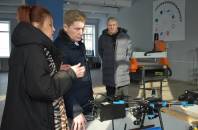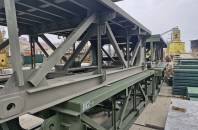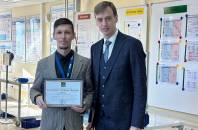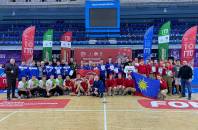|
Региональный журнал для деловых кругов Дальнего Востока
|
|
||||||||||||||||||||||
|
Среда| 15 Октября, 01:02 |
|
|
Тема номера
|
|||||||||||||||||||||

 Олег Кожемяко осуществил новогодние желания маленьких приморцев
В преддверии новогодних праздников заветные желания маленьких приморцев начинают сбываться. Так, Губернатор Приморского края Олег Кожемяко передал подарки от Деда Мороза двум маленьким приморцам: шестилетнему Мирону Глушаку из Тернейского муниципального округа и четырёхлетней Ольге Алимпиевой из Арсеньева.
Олег Кожемяко осуществил новогодние желания маленьких приморцев
В преддверии новогодних праздников заветные желания маленьких приморцев начинают сбываться. Так, Губернатор Приморского края Олег Кожемяко передал подарки от Деда Мороза двум маленьким приморцам: шестилетнему Мирону Глушаку из Тернейского муниципального округа и четырёхлетней Ольге Алимпиевой из Арсеньева.
 Родители ребят с ОВЗ обсудили вопросы образования и трудоустройства с представителями власти Приморья
Третья встреча клуба "На равных", призванного помогать гражданам решить непростые жизненные ситуации, состоялась в Приморье. В этот день участниками клуба стали родители детей с инвалидностью и ограниченными возможностями здоровья. Они обсудили с представителями власти вопросы образования и трудоустройства таких ребят.
Родители ребят с ОВЗ обсудили вопросы образования и трудоустройства с представителями власти Приморья
Третья встреча клуба "На равных", призванного помогать гражданам решить непростые жизненные ситуации, состоялась в Приморье. В этот день участниками клуба стали родители детей с инвалидностью и ограниченными возможностями здоровья. Они обсудили с представителями власти вопросы образования и трудоустройства таких ребят.
 Социальные предприниматели Приморья могут найти кадры и получить рекламу на радио при господдержке
Открыт прием заявок на две актуальные для социальных предпринимателей меры поддержки: "Размещение двух вакансий на HeadHunter" и "Размещение рекламы на радиостанции". Такой формат господдержки поможет социальному бизнесу Приморья продвигать свои услуги в осенний период и найти профессиональные кадры для расширения штата.
Социальные предприниматели Приморья могут найти кадры и получить рекламу на радио при господдержке
Открыт прием заявок на две актуальные для социальных предпринимателей меры поддержки: "Размещение двух вакансий на HeadHunter" и "Размещение рекламы на радиостанции". Такой формат господдержки поможет социальному бизнесу Приморья продвигать свои услуги в осенний период и найти профессиональные кадры для расширения штата.
 24 протокола составили на нарушителей противопожарного режима в приморских лесах
Лесничие и инспекторы в Приморье составили 24 протокола в отношении нарушителей особого противопожарного режима на землях лесного фонда. ОПР действует в большинстве муниципалитетов и подразумевает крупные штрафы за пренебрежение правилами пожарной безопасности.
24 протокола составили на нарушителей противопожарного режима в приморских лесах
Лесничие и инспекторы в Приморье составили 24 протокола в отношении нарушителей особого противопожарного режима на землях лесного фонда. ОПР действует в большинстве муниципалитетов и подразумевает крупные штрафы за пренебрежение правилами пожарной безопасности.
APEC countries - the Russian Far East’s most important partners
The choice of Vladivostok as the venue for the 2012 APEC summit has compelled many people in Russia to take a closer look at this regional international organization. Just what is APEC, which is widely expected to become the key “manager” of economic processes in the fastest-growing region of the world, and which Russia is proud to be a member of? How do Russia and its regions in the Russian Far Eastern Federal District benefit from cooperation with other APEC member states?
APEC countries are the RFE’s main partners
Let us start by looking at the significance of APEC countries for the Russian economy. APEC member states currently account for 23.9% of all Russian foreign trade, including 18% of exports and 33.9% of imports. Russia’s largest foreign trade partners in APEC in 2011 were China (42.4%), the US (15.9%), Japan (15.1%) and South Korea (12.7%). Together, these countries account for 86% of Russia’s foreign trade with APEC. However, they are quite unusual in the Russian foreign trade balance, as they are net exporters to Russia, whose trade deficit with them is nearly USD 1 billion.
APEC trade has a greater weight in the RFE’s economy: exports from and imports to APEC made up more than 81% of the RFE’s 2011 total international trade. However, the RFE only accounts for a small portion of Russia’s trade with APEC economies - just 14.3% of the total.
While China is Russia’s leading APEC trade partner, South Korea is the largest APEC partner for the RFE, with 34.7% of the total in 2011. China was second with 30%, closely followed by Japan with 27.5%. The US is fourth with 2.6%.
Raw materials are the main export item
APEC countries were the destination for 81.3% of all 2011 RFE exports by value. Notably, the total value of RFE exports increased by 33.6% last year.
South Korea was the main destination for RFE exports with USD 8,462.6 million, or 41.3% of the total. Crude oil and unrefined petroleum products accounted for most of the total (76.9%); frozen fish provided 7.3%, and liquefied natural gas (LNG) 5.6%.
Some 33.5% of RFE exports go to Japan, where the region sold USD 6,855.4 million worth of goods in 2011. Again, hydrocarbons accounted for the majority of exports: LNG provided 47.7%, while crude oil and unrefined petroleum products made up another 40.2%. China was third with USD 4,169.9 million (20.4%). In addition to crude oil and petroleum products (33.7% of the total), China also purchased significant amounts of frozen fish (22.1%) and unprocessed timber (13.8%). South Korea, Japan and China accounted for 95.2% of all RFE exports to APEC countries.
As this analysis clearly shows, commodities and resources represent a large majority of RFE exports to APEC countries.
What we import: cars, footwear and textiles
About 84% of the RFE’s imports come from APEC countries, and the total rose by 18.4% in 2011. China was the largest source, with USD 4,287.1 million, or 55.6% of the total. Customs data indicate that footwear was the main Chinese import, with 12.6% of the total. Bulldozers and excavators were imported for construction projects in Vladivostok and other large projects in the RFE, but heavy construction machinery accounted for only 3.2% of Chinese imports by value.
South Korea was second with USD 1,318.0 million, or 17.1% of the total. The main import categories were vehicle bodies (15.3%), vehicle parts and equipment (9.0%), and engines (7.3%).
Cars were also a key import from Japan, which was third with USD 905.2 million (11.7%). Passenger cars made up 15.1% of the RFE total, bulldozers and excavators 9.6%, and vehicle parts and equipment 8.9%.
The US provided 7.6% (USD 697.8 million) and was an important source of high-tech imports: helicopters, aircraft and space vehicles and rockets accounted for 15.2%, while heavy vehicles and trucks made up 7.7% and pork 6.4%.
China, South Korea, Japan, and the US accounted for a combined 92% of all RFE imports from APEC countries.
The lion’s share of imports are machinery, equipment and vehicles (43.8%). Textiles, textile items, and footwear are second (17.6%), with most imports in this category (98%) coming from China.
APEC countries invest in oil and gas
APEC countries are also an important source of foreign investment in the RFE, accounting for 11.5% of all foreign investment in the region.
Mineral resource development is the most appealing sector in the RFE economy for international investors (attracting 93.4% of total inflows). The charts attached to this text show the breakdown of investment in the RFE by APEC countries.
The Sakhalin-1 and Sakhalin-2 hydrocarbon projects on Sakhalin Shelf are the largest projects open to international investors. Construction of the Eastern Siberia - Pacific Ocean oil pipeline (ESPO) is another major energy infrastructure project with far-reaching global importance. Stage 1 of the pipeline, along with Kozmino Oil Port in the Primorsky Region, came on stream in late 2009. Russian oil champion Rosneft is getting ready to build Eastern Petrochemical Plant in Primorsky Region, and Russia expects APEC countries to be actively involved in this project.
The long-term program for the development of gas fields in Eastern Siberia and the Russian Far East provides for construction of a large gas pipeline to South Korea through North Korea, and plans are under consideration to build several more LNG plants.
APEC investors also see appeal in projects to develop mineral deposits of gold, silver, manganese, antimony, uranium and coal.
Timber needs processing
RFE regions with substantial forested areas stand to benefit handsomely from the introduction of top-of-the-line timber and lumber-processing technologies. The first medium/high-density fiberboard production facility has been built in the Khabarovsk Region, with funds provided by Malaysia’s Rimbunan Hijau Group. The facility started producing in 2011 and is expected to reach full capacity by 2013.
China has a very strong interest in gaining access to the timber resources of the RFE, as attested by Russia and China’s intentions to implement 10 timber-processing investment projects under the Program for Cooperation between regions of Eastern Siberia and the RFE and Northeastern China (planned for 2009-2018).
Global automotive giants enter the RFE market
In recent years, car assembly lines have been put into operation in the RFE by companies based in APEC countries, notably Japan and South Korea. A project financed by Korean investments to build a car assembly line in Vladivostok went into operation in late 2009. Sollers Far East is assembling Korean-designed SsangYong SUVs.
Japanese companies put together the RFE Japanese automotive cluster in 2011, under which Toyota intends to set up an assembly line in the Primorsky Region; Mazda has decided to build a line to assemble 30,000 cars per annum initially, and Honda is considering a similar move.
Russia’s United Shipbuilding Corporation has started construction of a modern shipyard together with Daewoo Shipbuilding & Marine Engineering Co. Ltd. to build large-tonnage ships in Bolshoi Kamen, Primorsky Region. The new shipyard would build gas carriers, large-tonnage Suezmax oil tankers, and oil production platforms for the Russian oil industry.
Other promising projects involving cooperation and integration of the RFE into the APEC economy envisage building competitive aircraft, most notably, series production of the Superjet 100 regional aircraft at KnAAPO OAO in the Khabarovsk Region.
Russia to build new railroads
Transportation plays a pivotal role in expanding cooperation between Russia and APEC countries, with railroads capable of efficient freight transport between Asia and Europe playing a key role. Work is under way to upgrade the Transsiberian Railroad, expand the BAM’s throughput capacity, and explore the possibility of integrating the Northern Sea Route into the combined cargo transportation system linking Asia and Europe.
A joint project with South Korea is under consideration to link the Transsiberian and Transkorean railroads.
Agricultural land in the region can be very lucrative
Agriculture is a new area of cooperation between the RFE and APEC countries. Russia could become an APEC leader in exports of environmentally clean produce and ready-to-consume food.
Dialogue in this area became possible as global agricultural produce markets became tighter, genetically-modified products appeared on the market, and overall global food exports declined (Japan alone is estimated to require 6 million metric tons of imported wheat).
Japan is interested in sourcing beans, soybeans and buckwheat from the RFE, while Korean companies are ready to become involved in creating a soybean production and processing cluster.
Russia turns its attention to the Asia-Pacific Region
Russia is putting together a list of large investment proposals for the APEC Summit and some of them are expected to be true breakthroughs.
Beyond any doubt, Russia sees APEC and many of its members as strategic partners, much more promising and open-minded than European countries, which tend to tie economic cooperation to Russia to various political goals and objectives. As a result, Asia-Pacific business interests may receive offers to participate in some very interesting projects and assets.
However, the Vladivostok APEC summit is only a small fraction of what Russia needs to do to ensure that APEC investors come here to stay, and most of the hardest work still lies ahead.
- Дальневосточный фокус. Как делать бизнес на Дальнем Востоке?
- Дрейф в штиль. Куда идет дальневосточный бизнес
- Акцент на береговую зону
- "РЖД" берет повышенный план
- Банки сняли отраслевые барьеры малому бизнесу на Дальнем Востоке
- Рейтинг 100 крупнейших компаний Дальнего Востока по выручке и темпам роста показывает реальные дела
- Рецепты выживания: Рейтинг эффективности бизнеса 100 крупнейших компаний Дальнего Востока
- По "Улице Дальнего Востока" с любопытством и восторгом
- Проект "Приморский маршрут": Приморский край: есть чем впечатлиться
- ТОП крупнейших компаний Дальнего Востока расширился до 150
 #ПозывнойКультура: Дед Мороз поздравил участников СВО в госпитале ТОФ с наступающим Новым годом
В преддверии Нового года агитбригада #ПозывнойКультура побывала в госпитале Тихоокеанского флота в субботу, 28 декабря. Для участников СВО, находящихся на лечении и реабилитации, прозвучали музыкальные поздравления. Со словами самых теплых пожеланий подарки военнослужащим вручила заместитель Председателя Правительства Приморского края – министр культуры и архивного дела Елена Бронникова.
#ПозывнойКультура: Дед Мороз поздравил участников СВО в госпитале ТОФ с наступающим Новым годом
В преддверии Нового года агитбригада #ПозывнойКультура побывала в госпитале Тихоокеанского флота в субботу, 28 декабря. Для участников СВО, находящихся на лечении и реабилитации, прозвучали музыкальные поздравления. Со словами самых теплых пожеланий подарки военнослужащим вручила заместитель Председателя Правительства Приморского края – министр культуры и архивного дела Елена Бронникова.
 Губернатор Приморья оценил оснащение Индустриального колледжа в Арсеньеве
Очередной день работы Губернатора Приморского края Олега Кожемяко в муниципалитетах региона начался с посещения Приморского индустриального колледжа в Арсеньеве. Глава региона изучил новое оборудование, на котором готовят специалистов технических специальностей.
Губернатор Приморья оценил оснащение Индустриального колледжа в Арсеньеве
Очередной день работы Губернатора Приморского края Олега Кожемяко в муниципалитетах региона начался с посещения Приморского индустриального колледжа в Арсеньеве. Глава региона изучил новое оборудование, на котором готовят специалистов технических специальностей.
 Комплекты быстровозводимых мостов начали поставлять в Приморье
Началась поставка средних автодорожных разборных мостов (САРМ) для проведения аварийно-восстановительных работ на дорогах Приморья. Всего на следующий год закуплено 11 комплектов. При необходимости комплекты САРМ будут использованы для оперативного восстановления проездов во время паводков.
Комплекты быстровозводимых мостов начали поставлять в Приморье
Началась поставка средних автодорожных разборных мостов (САРМ) для проведения аварийно-восстановительных работ на дорогах Приморья. Всего на следующий год закуплено 11 комплектов. При необходимости комплекты САРМ будут использованы для оперативного восстановления проездов во время паводков.
 Почти 900 сотрудников предприятий Приморья уже владеют бережливыми технологиями благодаря нацпроекту "Производительность труда"
Итоги реализации национального проекта "Производительность труда" и планы на будущее озвучил министр экономического развития Приморья Андрей Блохин на награждении команды Регионального центра компетенций. За четыре года работы нацпроекта реализовано 78 проектов по внедрению бережливых технологий на предприятиях края.
Почти 900 сотрудников предприятий Приморья уже владеют бережливыми технологиями благодаря нацпроекту "Производительность труда"
Итоги реализации национального проекта "Производительность труда" и планы на будущее озвучил министр экономического развития Приморья Андрей Блохин на награждении команды Регионального центра компетенций. За четыре года работы нацпроекта реализовано 78 проектов по внедрению бережливых технологий на предприятиях края.


